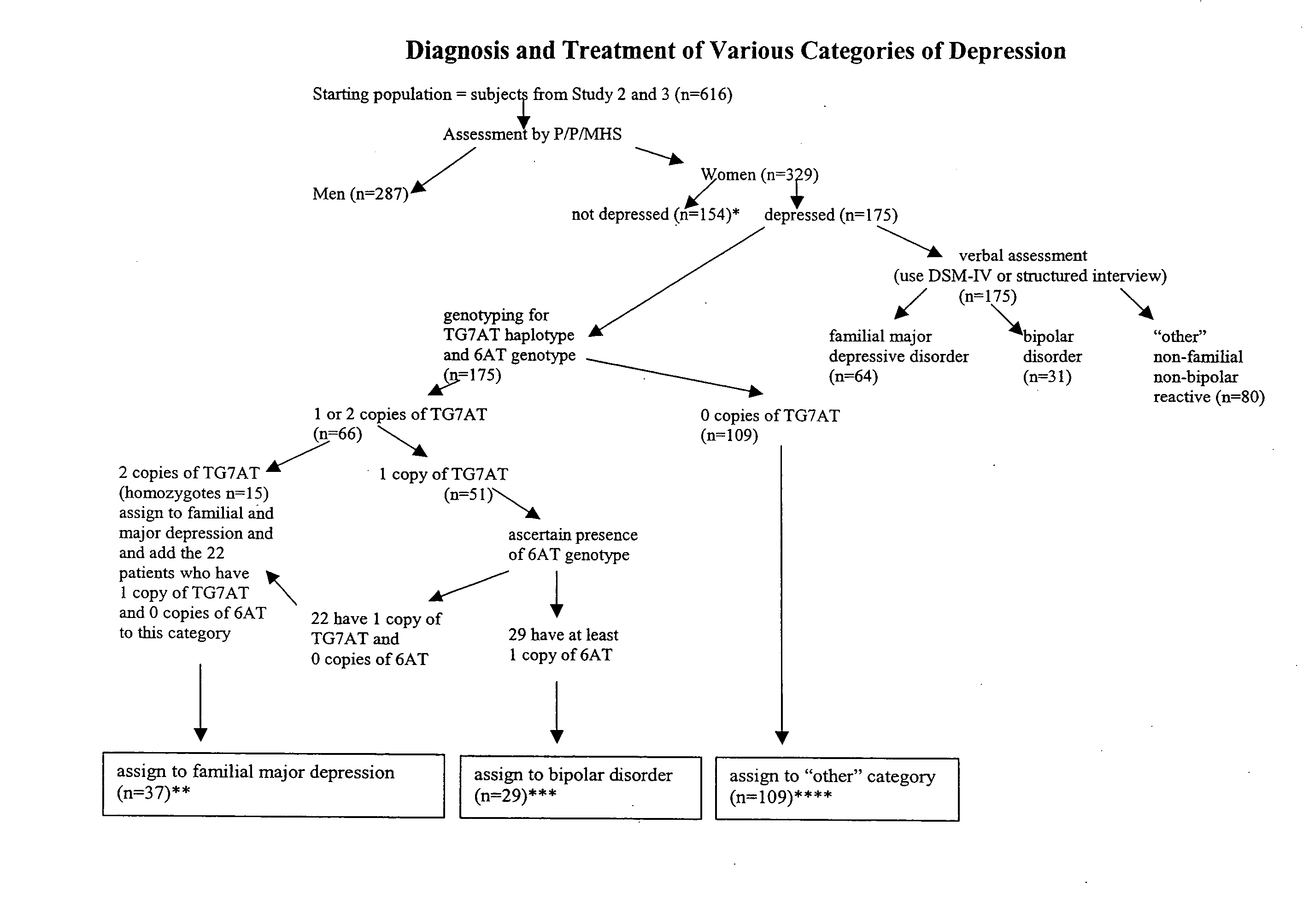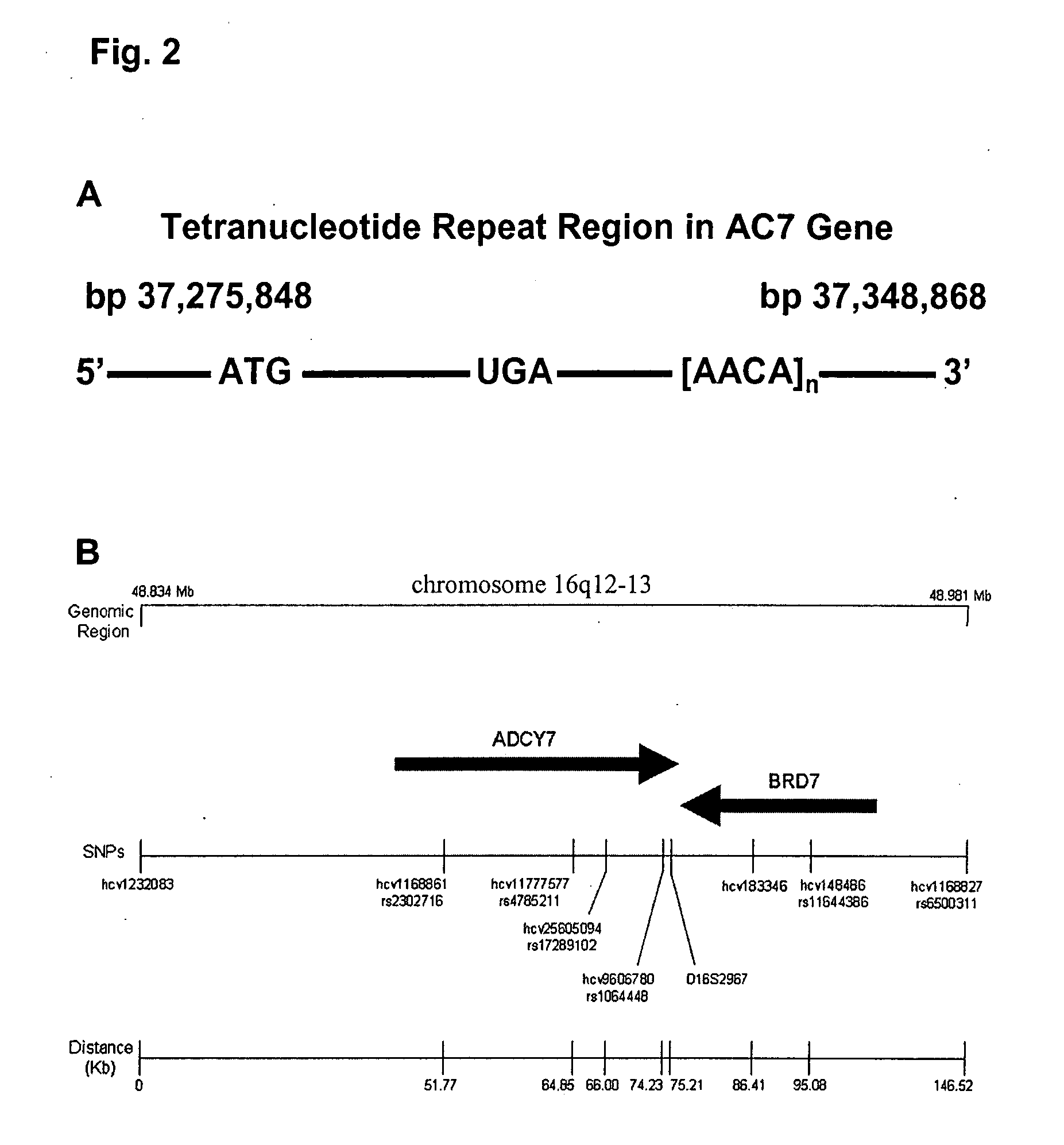Genetic diagnosis of depression
a genetic diagnosis and gene technology, applied in the field of genetic diagnosis of depression, can solve the problems of agitation, sleep disturbance, fatigue, and inability to self-reproach or guilt,
- Summary
- Abstract
- Description
- Claims
- Application Information
AI Technical Summary
Benefits of technology
Problems solved by technology
Method used
Image
Examples
example 1
Study Subjects and Interviews
[0166]Study 1 subjects were recruited for participation in the World Health Organization / Inter-national Study for Biomedical Research on Alcoholism (WHO / ISBRA) Collaborative Study on State and Trait Markers for Alcoholism. Subjects were excluded from the study if they manifested medical or psychiatric disorders that made them unable to respond to survey questions or if they used intravenous drugs. Participants from the study centers in Montreal, Helsinki, and Sydney were included in the study and subjects of Caucasian descent were used for association analysis. After the initial screening, and before a translated version of the WHO / ISBRA Interview Schedule was administered, patients provided informed consent. On the same day as the interview, biological samples including urine and blood were collected (Glanz et al., Alcoholism Clin Exp Res, 26:1047-1061, 2002). Caucasian subjects from the Montreal Study Center, recruited as described for Study 1, were us...
example 2
Blood and DNA Sample Acquisition
[0184]For Studies 1 and 2 blood was collected at the time of the interview via standard venipuncture technique into vacutainers containing EDTA for preparation of lymphocytes and platelets. Within two hours of collection, the platelets were prepared by centrifuging the blood samples at 700×g for 10 min at room temperature. The platelet-rich plasma layer was transferred to a fresh centrifuge tube and again centrifuged for 10 min at 700×g at room temperature. The upper platelet-rich layer was transferred to a second fresh centrifuge tube and centrifuged at 2800×g for 15 min at room temperature. The platelet pellet was recovered and stored at −70° C. until being shipped on dry ice to the Coordinating Center in Helsinki, Finland, and from there, to Denver, Colo., for analysis. The lymphocyte fraction was prepared by centrifugation and frozen at −70° C. until DNA was extracted at the Assay Center in Denver Colo. Genomic DNA was extracted from the lymphocyt...
example 3
Platelet Membrane Preparation
[0185]The frozen platelet pellet, obtained as described above in Example 2, was thawed and washed at 4° C. For washing, the platelet pellet was suspended in 1.5 ml of 50 mM Tris-HCl (pH 7.5) containing 20 mM EDTA and then centrifuged at 17,000×g for 10 min. This procedure was repeated, and the platelet pellet was then suspended in 1.5 ml of 5 mM Tris-HCl (pH 7.5) containing 5 mM EDTA and centrifuged again at 17,000×g for 10 min. The washed platelet pellet was suspended in 1.5 ml of 5 mM Tris-HCl (pH 7.5) containing 1 mM EDTA, using a hand-held Teflon homogenizer. The homogenate was diluted as necessary with 5 mM Tris-HCl (pH 7.5) containing 1 mM EDTA to attain a protein concentration of approximately 200 to 1000 μg / ml and used immediately for the assays of platelet AC activity. Protein determinations were performed using the Bicinchoninic Acid protein microtiter method (Pierce).
PUM
| Property | Measurement | Unit |
|---|---|---|
| Digital information | aaaaa | aaaaa |
| Fluorescence | aaaaa | aaaaa |
Abstract
Description
Claims
Application Information
 Login to View More
Login to View More - R&D
- Intellectual Property
- Life Sciences
- Materials
- Tech Scout
- Unparalleled Data Quality
- Higher Quality Content
- 60% Fewer Hallucinations
Browse by: Latest US Patents, China's latest patents, Technical Efficacy Thesaurus, Application Domain, Technology Topic, Popular Technical Reports.
© 2025 PatSnap. All rights reserved.Legal|Privacy policy|Modern Slavery Act Transparency Statement|Sitemap|About US| Contact US: help@patsnap.com



